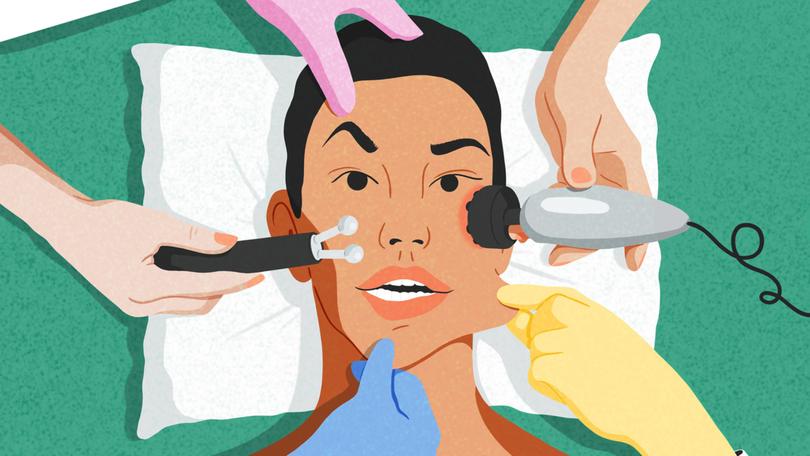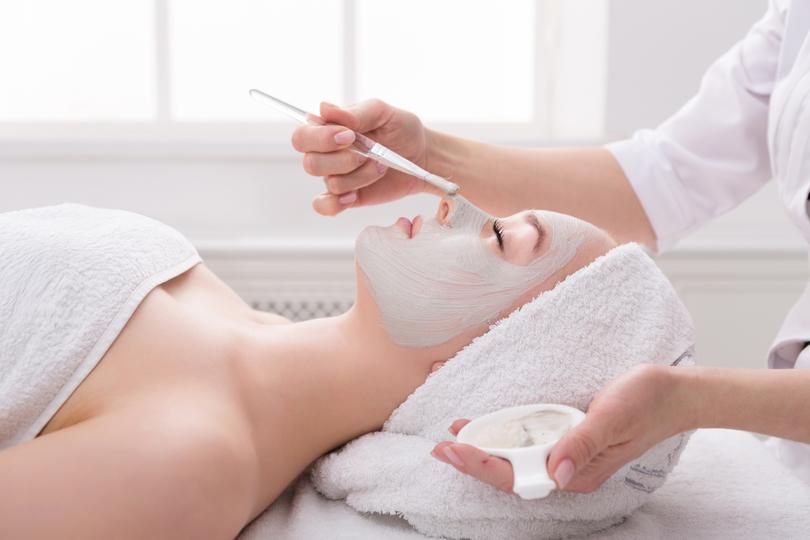The New York Times: The secret of the rich is now fetching $2700 for top-of-the-line treatments

Candice Miller is 42 and clinging to the millimeter of volume that held up her smile lines and cheekbones in her 30s. Once a week, unless she’s traveling, she goes to Aida Bicaj, a spa on the Upper East Side in New York City where the well-heeled get their faces lifted, tightened, de-puffed and brightened.
On a day in early December, Miller’s $US800 ($A1200) 90-minute “remodeling” facial included manual massage; double collagen masks (because of sun exposure during a Palm Beach Thanksgiving); microcurrent (electricity that stimulates muscles and is said to give the appearance of a lift) and radio frequency (heating the skin, leading it to contract and tighten). Miller, an influencer who goes by Mama & Tata on Instagram, gets her face remodeled twice a month. Next, she will try the spa’s $US850 ($A1255) microneedling treatment for the first time.
“I have friends doing their eyes and lower face-lifts and doing filler everywhere,” Miller said. “This makes you feel like your face doesn’t need that stuff — if you’re truly committing to going every week or every other week.” (Miller started getting Botox injections at age 35 and said she doesn’t use any filler.)
Sign up to The Nightly's newsletters.
Get the first look at the digital newspaper, curated daily stories and breaking headlines delivered to your inbox.
By continuing you agree to our Terms and Privacy Policy.The everyday facial has been disrupted.
Manual lifting through massage, microcurrent and radio frequency are changing the way we take care of our faces. The next-gen facial is not about cleaning your pores, but lifting your face.
Aestheticians like Bicaj, Iván Pol, Joanna Czech, Crystal Greene and Cynthia Rivas have practiced these techniques for years. But the types of facials they offer, once a secret of the rich or famous, have trickled into the mainstream — so much so that facial bars such as FaceGym, Silver Mirror and Glowbar, with their friendly branding and accessibly priced services, are poised to make the new facials as easy as a Drybar blowout.
FaceGym opened its first studio in 2015 and now has 17 locations across the United States, Britain and Australia. Two signature facials — one hands only and the other a combination of manual massage and microcurrent — cost $125 each. At Glowbar, there has been a 20% increase in microcurrent and radio frequency requests in the last six months, according to founder Rachel Liverman.
“This has cropped up in response to the injectable boom of the past 10 years,” said Allie Rowbottom, author of “Aesthetica,” a novel about a has-been influencer planning to undo all of her plastic surgery. “Consumers are really expecting that they’re going to have a tangible visual result at the end of any facial or aesthetic experience.”
Two factors are at play: a desire to mimic the effects of minimally invasive procedures one would get at a dermatologist’s office, like Botox or filler, and a compulsion to see those results instantly.

The average facial (steaming to open pores, extractions performed with a tiny lancet and the slathering on of a mask) may cleanse and get rid of gunk lurking beneath the surface — but it won’t get you “snatched” (a term used to mean sculpted, lifted and chiseled). That’s how Pol says clients look after he “carves” their facial contours. He has a spa in Los Angeles and works out of Hôtel Barrière Fouquet’s in Tribeca when visiting New York. In December, Emma Roberts posted on Instagram mid-facial (“getting snatched”) from the hotel.
Czech, an aesthetician trained in Eastern European facial massage, compares skin to dough that one can knead, mold and manipulate manually. Her experience proved prescient; she has worked on the faces of Kim Kardashian, Hailey Bieber and Jennifer Aniston, and, in March, she will open a third spa in Los Angeles. (The other two are in New York and Dallas.)
Greene, the founder of Crystal Greene Studio in SoHo, practices a similar method. La Sculpture, a manual facial priced at $US525 ($A750) for 60 minutes, makes up nearly 85 per cent of her treatments, she said. In February she is introducing a souped-up version: 90 minutes of manual massage, microcurrent and buccal massage, in which she goes inside the mouth to help sculpt the jawline. It will cost $US750 ($A1145).
People may be more aware these days, but social media, where Instagram and TikTok birth trends overnight, remains the most powerful manipulator of beauty standards. The “new facial” could be seen as a backlash to the cyborgian “Instagram face” that dominated our feeds in the last few years.
“Pumped and plumped,” Pol described the aesthetic that, he said, is passé.
Pol, a former makeup artist, is the founder of the Beauty Sandwich, the name of both a radio frequency-centric facial that costs $US1600 ($A2440) - $1US800 ($A2700) for the first session - with, he said, a yearlong waiting list, and a skin care line that sells a Secret Sauce, $US295 ($A450), and a Snatching Sauce, $US250 ($A381). The products are not serums, Pol said, but rather a “new category of skin care — a sauce.” (If one had to guess, “serum” would probably still be the correct classification.)
Last summer, Tea Hacic-Vlahovic, a novelist and podcast host, tried a FaceGym “workout,” as it calls its facials. Midway, her facialist showed her the half of the face she had treated.
“It was a big difference,” Hacic-Vlahovic said. “Half of my face looked like I had a face-lift.” The lift lasted for a few days, she said.
Hacic-Vlahovic’s outcome is fairly typical. Unlike injectables, where visible results can last for months, the chiseled lines of a sculpting facial wear off pretty quickly.
“I’ll do it right before a big event, the day before and the day of,” Rivas said.
Aestheticians stress that consistency is critical, especially with microcurrent treatments that stimulate the muscles in one’s face. Most recommend weekly facials for six to 12 weeks, followed by sessions every other week for optimal results. Bicaj and Czech say you can achieve good results with monthly sessions. Pol suggests four weeks between radio frequency sessions.
“It’s like having a personal trainer for the body, but for the face,” Bicaj said.
This article originally appeared in The New York Times.
© 2023 The New York Times Company
Originally published on The New York Times
